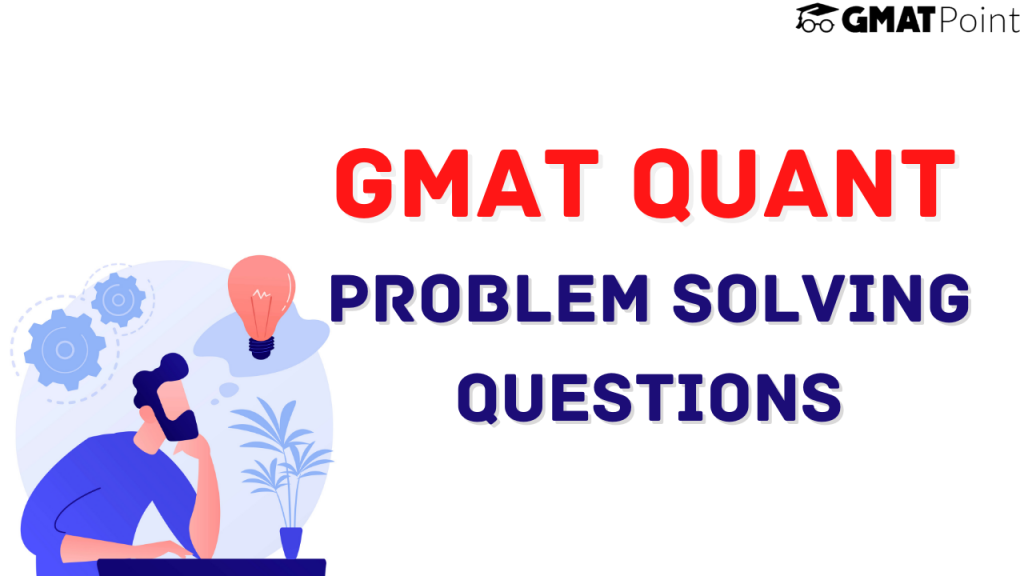GMAT Problem Solving Questions With Answers
Problem Solving questions constitute a major chunk of the Quant section of the GMAT. Of the 31 questions that appear in this section, you can expect close to 50% of the questions from problem-solving. In this article, we will be looking into –
- What are GMAT Quant Problem Solving Questions?
- 3 examples of GMAT Problem Solving Practice Questions
- 5 tips that can help you ace these questions.
Subscribe To GMAT Preparation Channel
What are GMAT Quant Problem Solving Questions?
Problem Solving or PS questions are questions that have a question followed by five options. They are very similar to any MCQ question that we come across in our school or university examinations. You need to solve the question and arrive at the answer and mark the correct choice.
There is only one correct answer in Problem Solving Questions.
Problem Solving questions are considered easier than Data Sufficiency questions because they are straightforward. Having said that, a preparation without a proper plan might prove disastrous for these questions.
Let us now take a look at a few Problem-Solving questions to get you started.
Examples – GMAT Problem Solving Questions
Question 1:
If a regular unbiased die is rolled twice, what is the probability of getting a sum greater than 10 in the two rolls?
Approach:
In probability, the probability of an event E = The number of favourable outcomes / Total number of outcomes
The first step is to calculate all favourable outcomes.
Let {x,y} represent the two rolls.
For getting a sum greater than 10, we can get a sum of 11 it a sum of 12.
Now, for a sum of 11, we can have these cases – {5,6}, {6,5}
For a sum of 12, we can have these cases – {6,6}
Hence, there are three favourable outcomes.
Total number of outcomes = 6*6 = 36
Hence, probability = 3/36 = 1/12.
Question 2:
The length of the equal sides of an isosceles triangle is 6 cm. What is the maximum possible area of the triangle(in square centimetres)?
Approach:
Let us assume that one of these 6 cm sides is the base and the angle that the other 6 cm side makes with the base is k degrees.
Now, we know that the area of a triangle whose 2 adjacent sides are known and the enclosed angle is known can be calculated as:
Area = (1/2)*a*b*sin(k)
a = First side
b = Second side
k is the angle enclosed.
Now, a and b are fixed as 6 cm each
If sin k is maximum = 1, the value will be maximum.
Hence, the maximum possible area = (1/2) x 6 x 6 = 18
Question 3:
If a set A has 16 distinct elements all of which are integers and set B necessarily has the square of all elements of set A, what can be the minimum number of elements in set B?
Approach:
If all 16 elements in A are distinct, say 1, 2, 3, …., 16, then B also has 16 elements 1, 4, 9, ….., 256.
However, to reduce the number of elements of B, we need to have as many elements as possible in A that also has their negative counterpart in A. For example, if 2 is an element, -2 should be an element as well. As a result, if 4 (square of both 2 and -2) is present in B, it will account for 2 elements in A.
Hence, we can have 8 positive numbers in A and their corresponding negative numbers in A. In this way, we can say that B will have a minimum of 8 elements.
Hence, the minimum possible number of elements in B is 8.
Note:
Though these examples provide a good sense of what type of GMAT Problem Solving questions you can expect, in no way do they represent the exhaustive list of concepts required for the Quantitative section of GMAT.
Tips to keep in mind:
- Try to take some time out from easy Problem Solving questions so that you can use that time to solve tricky Data Sufficiency questions. Data sufficiency questions usually take more time to solve than Problem Solving questions.
- Do not get stuck in a question for long. If you find yourself trapped in a question for long, take a guess and move on.
- Read the units carefully.
- Look out for negation words. For example: Which of the following are NOT possible values of x?
- Some questions can be solved faster by the use of options. Make sure you don’t solve these questions in a conventional way.
You can check out the Free GMAT Daily Targets on our platform.
Also, check out the Free GMAT Verbal Tests and Quant Tests.
If you are starting your GMAT preparation from scratch, do check out GMATPOINT.
Join GMATPoint Telegram Channel
Hope this article was helpful. Wish you all the best for the GMAT.
